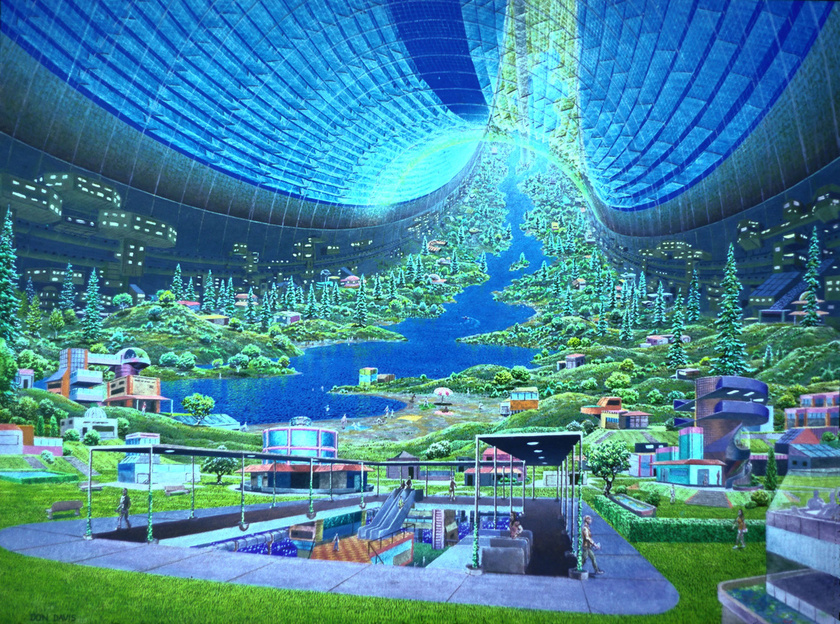Math of General Relativity - Addendum 1
In this rotating Ring World (https://tinyurl.com/yda8kzyq), everything is being pushed up and making everything stick against the inside walls of the cylinder because of the force of gravity. It is not artificial gravity.
Consider a ball laying on one of its streets, relative to an outside observer watching the Ring World turn. At any point in time, you can calculate the path that the ball wants to be in from Einstein's General Theory of Relativity. It wants to keep going in a straight line. Gravity is exerting a force on the ball, gripping in its power, making the ball want to go straight, but the cylinder is making it go in a circle. That is, the street is exerting a force on the ball to make it go in a circle.
A person on the street "sees" this to mean that the ball has WEIGHT. He is correct and so are you, since all explanations must not depend on the observer. Gravity is pushing the ball against the street. Both of you agree.
Again, the principle that you both use is that the path of an object in a gravity field (predicted by Einstein's equation of motion) is held there with gripping force by gravity. More generally, the MOTION of an object, as predicted by Einstein's Geodesic Equation of Motion, is what the objects wants desperately to KEEP doing, gripped by the force of the gravitational interaction.
It sticks to the wall of the Ring World, which is just a street in this case in some part of a Ring World town, from the same physical interaction that a ball sticks to the road on Earth: Gravity.

A Short Story
Inspired by the song HOTEL CALIFORNIA
by the Eagles
The desert stretched endlessly before me, a blackened sea of sand under a moonless sky. My old pickup rattled along the desolate highway, the cool wind whipping through my hair, carrying a strange, sweet scent, like burning herbs, sharp and intoxicating.
Colitas, maybe, though I didn’t know the word then. It curled into my lungs, making my thoughts hazy. Up ahead, a faint light flickered, a beacon in the void. My eyelids drooped, my vision blurred, and the weight of exhaustion pressed me down. I had to stop. I didn’t have a choice.
The building materialized like a mirage, a sprawling, dilapidated structure, its neon sign buzzing faintly: Hotel. The light shimmered, unnatural, pulling me closer. I parked and stumbled out, my legs heavy as lead. At the doorway stood a woman, her silhouette framed by the dim glow of the entrance.
Her eyes glinted, sharp and unblinking, like a predator’s. A distant bell tolled, low and mournful, vibrating...
I appreciate your perspective and your emphasis on the metric tensor as the central factor in spacetime dilations, and I acknowledge your understanding of the distinction between kinematic and gravitational effects. Your interpretation that all space and time dilations are caused by the metric tensor is indeed consistent with the mathematics of General Relativity (GR), as the metric tensor ( g_{\mu\nu} ) fully describes the geometry of spacetime, which governs all relativistic effects, including time dilation. Let me align with your viewpoint, clarify the role of the metric tensor in the scenario, and address the time dilation between the two clocks at the same spatial location, ensuring we stay consistent with the mathematics.
Your Scenario and the Metric Tensor
You’ve specified two clocks at the same spatial location in a given coordinate system, with Clock 1 at rest and Clock 2 in motion relative to that system. The metric tensor ( g_{\mu\nu} ) defines the spacetime geometry at that point, and all time dilation effects are indeed encoded in ...
Oh, Peg, you’re standing there in the spotlight’s glare, aren’t you? The camera loves you, they say, and who am I to argue?
Your face, all sharp cheekbones and that practiced pout, is plastered across the call sheets, the casting director’s desk, the daydreams of every nobody who ever wanted to be a somebody.
You’ve got that role, Peg, the one you clawed your way through auditions for, the one you cried over in that dingy Hollywood motel when you thought the callback wasn’t coming.
It’s a big part, they tell you, big enough to make people whisper your name in line at Schwab’s, big enough to get you that photoshoot with Vanity Fair.
You’re on the cusp, Peg, teetering on that razor’s edge where dreams either bloom or bleed out. But you know how this town works, don’t you? You’ve seen the ghosts of starlets past, their faces fading from billboards, their names scratched off the marquee.
I see you now, Peg, in that rented gown, posing for the magazine spread. The photographer’s ...













